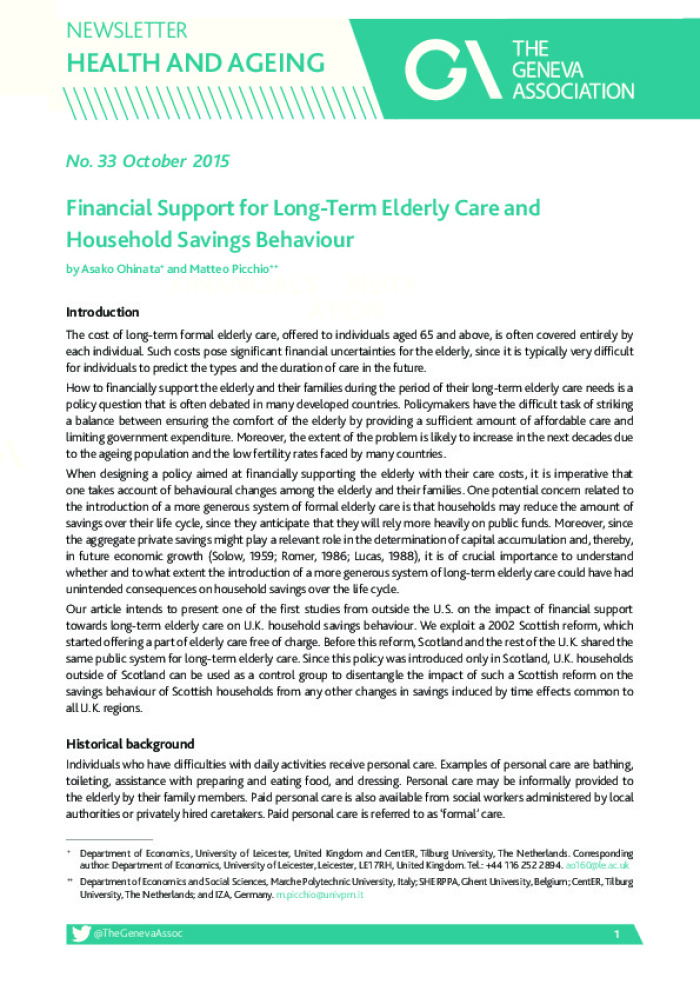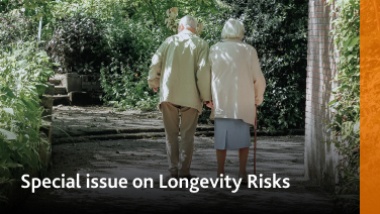Financial Support for Long-Term Elderly Care and Household Savings Behaviour
Article from Health and Ageing newsletter 33

1 FINANCIAL SBILITY AT ION NEWSLETTER HEALTH AND AGEING No. 33 October 2015 Financial Support for Long-Term Elderly Care and Household Savings Behaviour by Asako Ohinata+ and Matteo Picchio++ Introduction The cost of long-term formal elderly care, offered to individuals aged 65 and above, is often covered entirely by each individual. Such costs pose significant financial uncertainties for the elderly, since it is typically very difficult for individuals to predict the types and the duration of care in the future. How to financially support the elderly and their families during the period of their long-term elderly care needs is a policy question that is often debated in many developed countries. Policymakers have the difficult task of striking a balance between ensuring the comfort of the elderly by providing a sufficient amount of affordable care and limiting government expenditure. Moreover, the extent of the problem is likely to increase in the next decades due to the ageing population and the low fertility rates faced by many countries. When designing a policy aimed at financially supporting the elderly with their care costs, it is imperative that one takes account of behavioural changes among the elderly and their families. One potential concern related to the introduction of a more generous system of formal elderly care is that households may reduce the amount of savings over their life cycle, since they anticipate that they will rely more heavily on public funds. Moreover, since the aggregate private savings might play a relevant role in the determination of capital accumulation and, thereby, in future economic growth (Solow, 1959; Romer, 1986; Lucas, 1988), it is of crucial importance to understand whether and to what extent the introduction of a more generous system of long-term elderly care could have had unintended consequences on household savings over the life cycle. Our article intends to present one of the first studies from outside the U.S. on the impact of financial support towards long-term elderly care on U.K. household savings behaviour. We exploit a 2002 Scottish reform, which started offering a part of elderly care free of charge. Before this reform, Scotland and the rest of the U.K. shared the same public system for long-term elderly care. Since this policy was introduced only in Scotland, U.K. households outside of Scotland can be used as a control group to disentangle the impact of such a Scottish reform on the savings behaviour of Scottish households from any other changes in savings induced by time effects common to all U.K. regions. Historical background Individuals who have difficulties with daily activities receive personal care. Examples of personal care are bathing, toileting, assistance with preparing and eating food, and dressing. Personal care may be informally provided to the elderly by their family members. Paid personal care is also available from social workers administered by local authorities or privately hired caretakers. Paid personal care is referred to as ?formal? care. + Department of Economics, University of Leicester, United Kingdom and CentER, Tilburg University, The Netherlands. Corresponding author: Department of Economics, University of Leicester, Leicester, LE1 7RH, United Kingdom. Tel.: +44 116 252 2894. ao160@le.ac.uk ++ Department of Economics and Social Sciences, Marche Polytechnic University, Italy; SHERPPA, Ghent University, Belgium; CentER, Tilburg University, The Netherlands; and IZA, Germany. m.picchio@univpm.it @TheGenevaAssoc HEALTH AND AGEING





